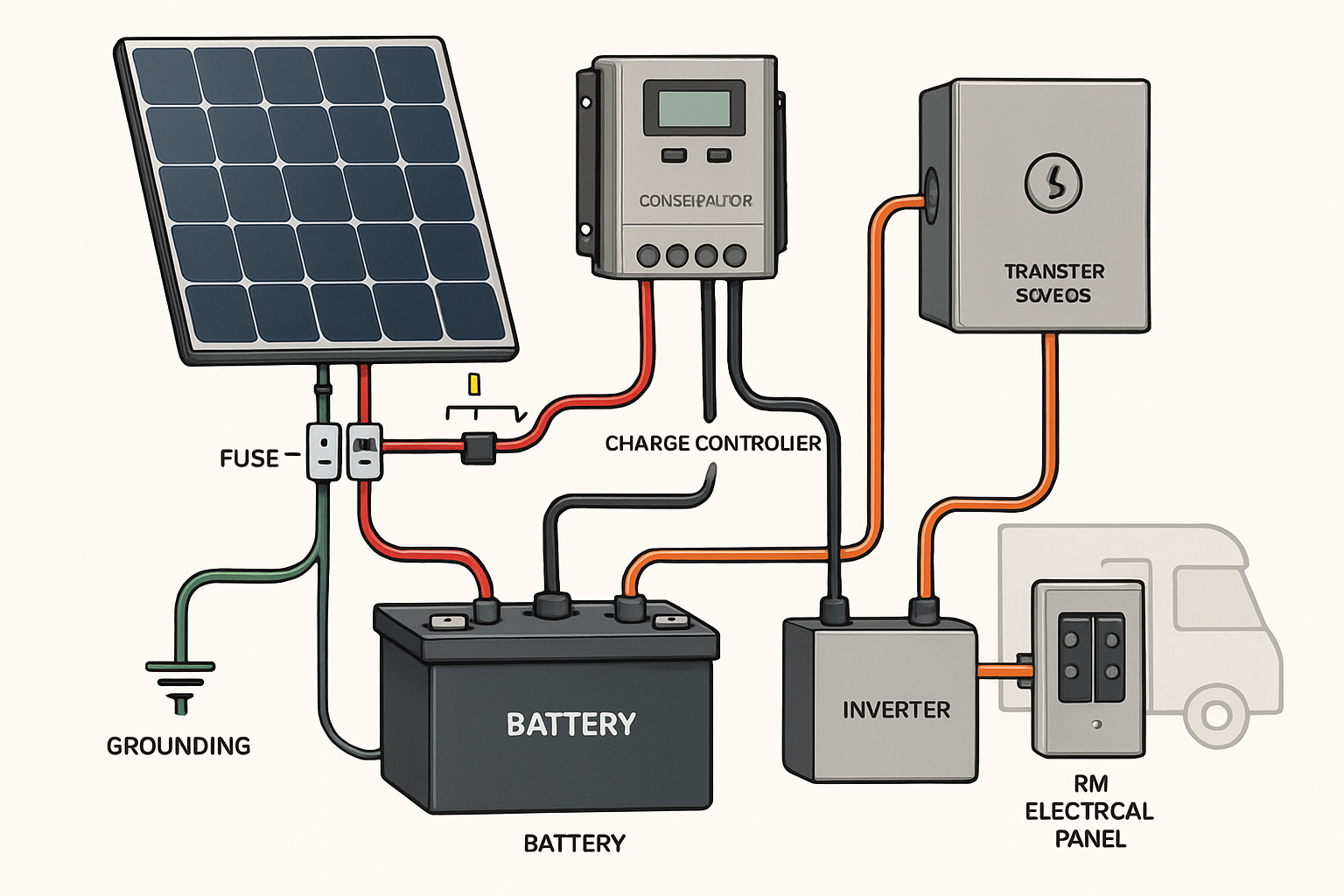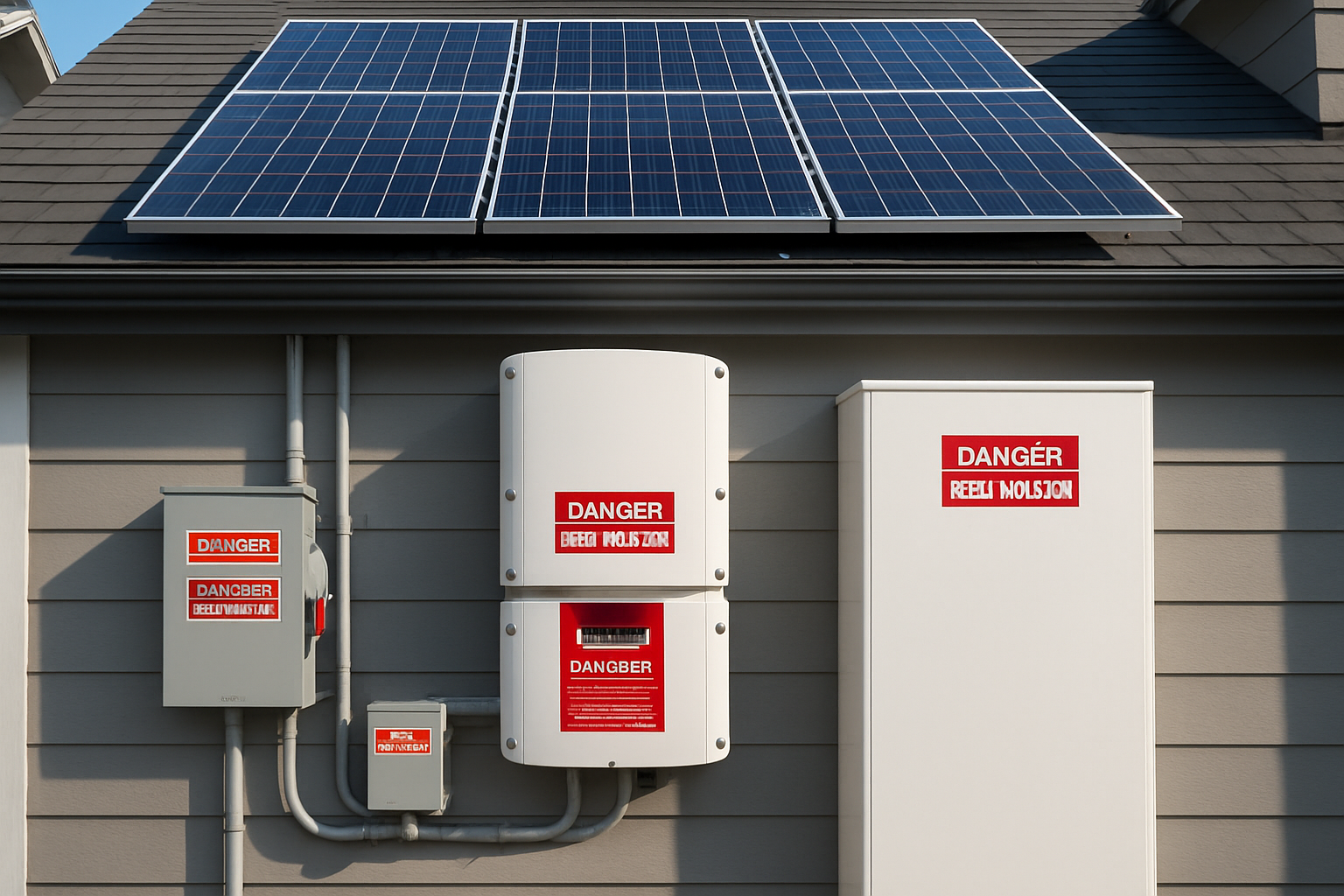Connecting a portable solar system to the grid requires careful attention to safety and regulations. A critical, yet often overlooked, element is the safety notice. These labels are not just suggestions; they are vital communication tools that protect utility workers, first responders, and your equipment. Improper notices can lead to dangerous situations, failed inspections, and significant penalties. Understanding the common pitfalls in creating and placing these notices is the first step toward a safe and compliant grid interconnection.
Why Accurate Grid Interconnection Notices Are Non-Negotiable
Proper labeling is a cornerstone of a safe solar installation. The risks associated with incorrect or missing notices are substantial, affecting personnel safety, regulatory compliance, and the longevity of your hardware.
Protecting Utility Personnel and First Responders
During a power outage, utility workers assume downed lines are de-energized. A solar system backfeeding power onto the grid creates a life-threatening hazard. Clear, standardized notices at key locations—like the main service panel—alert personnel to an active power source, allowing them to take necessary precautions. Without these warnings, the risk of electrocution is severe.
Ensuring System Compliance and Avoiding Penalties
The National Electrical Code (NEC) provides detailed regulations for the safe installation of electrical equipment, including specific requirements for solar warning labels. Local utilities and municipalities adopt and enforce these standards. An installation with non-compliant notices will fail inspection, leading to delays and potential fines. Proper labeling is a fundamental requirement for receiving permission to operate your system.
Safeguarding Your Equipment
Correct notices are part of an integrated safety system. They work in conjunction with components like rapid shutdown devices and disconnect switches. Clear identification ensures that in an emergency, the system can be de-energized correctly, preventing damage to your inverter, batteries, and other connected appliances from power surges or improper handling.
The 9 Most Common Mistakes in Portable Solar Safety Notices
Avoiding these common errors ensures your safety notices are effective, compliant, and serve their intended purpose of protecting everyone who interacts with your electrical system.
1. Vague or Ambiguous Language
A notice that says 'Solar Power Here' is unhelpful. Safety labels must use precise, standardized language. According to NEC guidelines, warnings like 'CAUTION: MULTIPLE SOURCES OF POWER' and 'PV SYSTEM DISCONNECT' are required to eliminate ambiguity. The text should be clear and direct.
2. Incorrect Placement of Notices
A perfectly crafted label is useless if no one can see it. The NEC mandates that labels must be placed at specific points, including every disconnect, junction box, and at the main service panel where the system interconnects with the grid. They must be visible after installation is complete.
3. Missing Critical Information
Safety notices must include key technical data. This includes the system's maximum voltage, operating current, and the location of the rapid shutdown switch. Omitting these details leaves service personnel without the information they need to work safely.
4. Using Non-Durable Materials
A handwritten note or a paper label will not last. The NEC requires labels to be durable and weather-resistant. Engraved plastic placards or UV-stabilized labels ensure the warning remains legible for the life of the system.
5. Ignoring AC and DC-Specific Warnings
Solar power systems contain both direct current (DC) from the panels and alternating current (AC) after the inverter. These circuits must be labeled distinctly. Clearly marking conduits and disconnects as 'PV SYSTEM DC DISCONNECT' or with AC voltage information prevents dangerous confusion for electricians.
6. Overlooking the Point of Interconnection
The exact point where your solar system connects to the building's wiring must be clearly marked. This is often a back-fed breaker in the main service panel. A label stating 'WARNING: SOLAR BACKFEED' alerts anyone working on the panel that it is energized from two sources.
7. Forgetting Rapid Shutdown System (RSS) Labels
For firefighter safety, modern solar installations require a rapid shutdown system. The location of the RSS initiator must be clearly labeled. This allows first responders to quickly de-energize the solar array on the roof in an emergency.
8. Confusing Off-Grid and Grid-Tied Terminology
A portable solar system may have off-grid capabilities, but if it is interconnected with the grid, all its notices must reflect that. Using off-grid language can mislead utility workers into thinking the system is isolated when it is not, creating a serious backfeed risk.
9. Neglecting Updates After System Modifications
If you add more panels, upgrade your inverter, or install a battery, your system's specifications change. Your safety notices must be updated immediately to reflect the new operating voltage or the presence of an energy storage system. Outdated labels provide false information, which can be more dangerous than no label at all.
A Comparative Checklist for Effective Notices
To provide a clear reference, this table contrasts common labeling errors with their compliant solutions.
| Mistake | Potential Hazard | Compliant Solution |
|---|---|---|
| Handwritten paper label | Fades and deteriorates, becoming illegible. | Use engraved plastic or UV-resistant, weatherproof labels. |
| Label placed behind equipment | Not visible to service personnel or first responders. | Place labels at the main service disconnect, interconnection point, and on all related equipment and conduits. |
| Missing voltage/current data | Technicians cannot assess electrical risk accurately. | Include maximum voltage, operating current, and fault current on relevant labels. |
| No 'Rapid Shutdown' label | Firefighters cannot safely de-energize the rooftop array. | Install a clear label identifying the location and function of the rapid shutdown switch. |
| Generic 'Solar' warning | Does not specify the hazard or required action. | Use specific NEC-compliant text like 'CAUTION: MULTIPLE SOURCES OF POWER'. |
Integrating Advanced Components and Their Labeling Needs
As solar technology evolves, so do the labeling requirements. Systems with energy storage and smart inverters demand additional, specific notices.
Labeling for Energy Storage Systems (ESS)
When you add batteries to your system, you introduce new considerations. Notices must indicate the presence of the battery, its chemistry (e.g., lithium-ion), and the location of the battery disconnect. Understanding the performance metrics of your storage is also key. As detailed in this guide on solar storage performance, factors like Depth of Discharge (DoD) and cycle life influence safety protocols and should be reflected in your system documentation.
The Role of Smart Inverters and Interconnection Standards
Modern inverters are sophisticated devices that actively manage the connection to the grid. Their proper function is critical for grid stability. According to a report from the U.S. Department of Energy, The SunShot Story, advanced inverters have been instrumental in helping utilities manage high penetrations of solar energy. Furthermore, the International Energy Agency (IEA) emphasizes in its Getting Wind and Sun onto the Grid report that comprehensive grid connection codes are essential as renewables become more prevalent. A subsequent IEA publication, System Integration of Renewables, reinforces that these frameworks are vital for managing the system's overall load and ensuring reliability.
Moving Forward with Confidence
Correctly labeling a portable solar system for grid interconnection is not an area for shortcuts. Clarity, correct placement, durability, and accuracy are the pillars of a compliant and safe installation. These notices are the silent guardians of your system, communicating critical information when it matters most. Take the time to review your system's labels today. Ensuring they are accurate and compliant is a fundamental part of being a responsible solar energy producer.
Disclaimer: This information is for educational purposes only and does not constitute professional electrical or legal advice. Always consult with a qualified electrician and your local utility to ensure compliance with all applicable codes and regulations.
Frequently Asked Questions
What is the most critical safety notice for a grid-tied portable solar system?
The most critical notices are those at the main service panel and the point of interconnection, as these are the first places emergency responders and utility workers will look. A clear rapid shutdown label is also vital for firefighter safety.
Do I need different labels for a portable solar generator versus a fixed installation?
If the portable generator has the capability to connect to your home's wiring (and thus the grid), it must have the same safety notices as a permanent grid-tied system. A standalone, off-grid power station used only for charging devices does not require grid interconnection notices.
How often should I check my solar safety notices?
It is good practice to inspect all safety labels annually for fading, damage, or peeling. They should also be reviewed and updated immediately following any modification or upgrade to your solar energy system.





Leave a comment
All comments are moderated before being published.
This site is protected by hCaptcha and the hCaptcha Privacy Policy and Terms of Service apply.